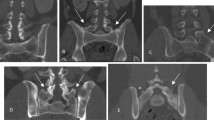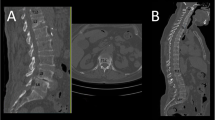Abstract
Purpose
To evaluate lumbosacral transitional vertebrae (LSTV) frequency in patients with low back pain and lumbar disc herniation (LDH) and to analyze correlations between LSTV presence and intervertebral disc degeneration.
Methods
This retrospective study included patients with low back pain applying between January 2021 and August 2021. Inclusion criteria were age of 18–65, presence of a standing lumbosacral Xray and a lumbar MRI taken within 2 weeks of the indexed symptoms. Patients with a history of spondylolisthesis, spondylodiscitis, scoliosis and vertebral neoplasia were excluded. A total of 1821 patients met the inclusion criteria. Radiographs and MRIs were evaluated by 2 radiologists.
Results
Of all patients, 61.4% were female and the mean age was 43.2 ± 12.2. LDH was detected in 57.7% of patients while a LSTV was present in 43.3%. Sacralization and LSTV were significantly different between the patients with and without an LDH. Patients with LSTV had a higher incidence of a LDH affecting 3 or more intervertebral disc levels (p < 0.001). There was a significant difference in-between LSTV and non-LSTV groups regarding the M1 and M2 intervertebral disc degeneration levels.
Conclusion
A LDH is more common in the presence of a LSTV. Female sex is highly correlated with herniation. Three or more intervertebral disc levels are affected in the presence of an LSTV. Significantly higher degeneration incurs at the M1 and M2 intervertebral levels. Sacralization is a risk factors for a lumbar disc herniation.

Similar content being viewed by others
Availability of data and material
Data and material on this study will be made available to editors upon request.
Code availability
N/A.
References
Balagué F, Mannion AF, Pellisé F, Cedraschi C (2012) Non-specific low back pain. Lancet 379:482–491
Hoy D, Bain C, Williams G, March L, Brooks P et al (2012) A systematic review of the global prevalence of low back pain. Arthritis Rheum 64:2028–2037
Diamond S, Borenstein D (2006) Chronic low back pain in a working-age adult. Best Pract Res Clin Rheumatol 20:707–720
Delport EG, Cucuzzella TR, Kim N, Marley J, Pruitt C et al (2006) Lumbosacral transitional vertebrae: incidence in a consecutive patient series. Pain Physician 9:53.
Kurt EE, Turkyilmaz AK, Dadali Y, Erdem HR, Tuncay F (2016) Are transitional vertebra and spina bifida occulta related with lumbar disc herniation and clinical parameters in young patients with chronic low back pain? Eurasian J Med 48:177.
Sekharappa V, Amritanand R, Venkatesh Krishnan KSD (2014) Lumbosacral transition vertebra: prevalence and its significance. Asian Spine J 8:51.
Bron JL, van Royen BJ, Wuisman P (2007) The clinical significance of lumbosacral transitional anomalies. Acta Orthopaedica Belgica 73:687.
Tang M, Yang X-f, Yang S-w, Han P, Ma Y-m et al (2014) Lumbosacral transitional vertebra in a population-based study of 5860 individuals: prevalence and relationship to low back pain. Euro J Radiol 83:1679–1682.
Elster AD (1989) Bertolotti's syndrome revisited. Transitional vertebrae of the lumbar spine. Spine 14:1373–1377.
Farshad-Amacker NA, Herzog RJ, Hughes AP, Aichmair A, Farshad M (2015) Associations between lumbosacral transitional anatomy types and degeneration at the transitional and adjacent segments. Spine J 15:1210–1216
Fardon DF, Williams AL, Dohring EJ, Murtagh FR, Rothman SLG et al (2014) Lumbar disc nomenclature: version 2.0: Recommendations of the combined task forces of the North American Spine Society, the American Society of Spine Radiology and the American Society of Neuroradiology. Spine J 14:2525–2545.
Hou L, Bai X, Li H, Gao T, Li W et al (2020) Lumbar plain radiograph is not reliable to identify lumbosacral transitional vertebra types according to Castellvi classification principle. BMC Musculoskelet Disord 21:1–8
Pfirrmann CW, Metzdorf A, Zanetti M, Hodler J, Boos N (2001) Magnetic resonance classification of lumbar intervertebral disc degeneration. Spine 26:1873–1878
Apaydin M, Uluc M, Sezgin G (2019) Lumbosacral transitional vertebra in the young men population with low back pain: anatomical considerations and degenerations (transitional vertebra types in the young men population with low back pain). Radiol Med (Torino) 124:375–381
Fidan F, Çay N, Asiltürk M, Veizi E (2021) The incidence of congenital lumbosacral malformations in young male Turkish military school candidates population. J Orthopaedic Sci 2021:S0949-2658
Otani K, Konno S, Kikuchi S (2001) Lumbosacral transitional vertebrae and nerve-root symptoms. J Bone Joint Surg 83:1137–1140.
Jancuska JM, Spivak JM, Bendo JA (2015) A review of symptomatic lumbosacral transitional vertebrae: Bertolotti's syndrome. Int J Spine Surg, 9
Nardo L, Alizai H, Virayavanich W, Liu F, Hernandez A et al (2012) Lumbosacral transitional vertebrae: association with low back pain. Radiology 265:497–503
Mahato NK (2012) Lumbosacral transitional vertebrae: variations in low back structure, biomechanics, and stress patterns. J Chiropr Med 11:134
Mahato NK (2011) Facet dimensions, orientation, and symmetry at L5–S1 junction in lumbosacral transitional states. Spine 36:E569–E573
Brinjikji W, Luetmer PH, Comstock B, Bresnahan BW, Chen L et al (2015) Systematic literature review of imaging features of spinal degeneration in asymptomatic populations. Am J Neuroradiol 36:811–816
Luoma K, Vehmas T, Raininko R, Luukkonen R, Riihimäki H (2004) Lumbosacral transitional vertebra: relation to disc degeneration and low back pain. Spine 29:200–205
Aihara T, Takahashi K, Ogasawara A, Itadera E, Ono Y et al (2005) Intervertebral disc degeneration associated with lumbosacral transitional vertebrae: a clinical and anatomical study. J Bone Joint Surg 87:687–691.
Dammers R, Koehler PJ (2002) Lumbar disc herniation: level increases with age. Surg Neurol 58:209–212
Jönsson B, Strömqvist B (1995) Influence of age on symptoms and signs in lumbar disc herniation. Eur Spine J 4:202–205
Bulut M, Uçar BY, Uçar D, Azboy İ, Demirtaş A et al (2013) Is sacralization really a cause of low back pain? ISRN Orthop 2013:839013
Chang HS, Nakagawa H (2004) Altered function of lumbar nerve roots in patients with transitional lumbosacral vertebrae. Spine 29:1632–1635
Wigh RE, Anthony Jr HF (1981) Transitional lumbosacral discs. probability of herniation. Spine 6:168–171
van Tulder MW, Assendelft WJ, Koes BW, Bouter LM (1997) Spinal radiographic findings and nonspecific low back pain: a systematic review of observational studies. Spine 22:427–434
Kobayashi K, Ando K, Nishida Y, Ishiguro N, Imagama S (2018) Epidemiological trends in spine surgery over 10 years in a multicenter database. Eur Spine J 27:1698–1703
Acknowledgements
The authors would like to thank Dr.Betül G. Y. Veizi and Dr. Mücahit Yıldız for their valuable contribution to this study.
Funding
The authors received no funding before, during or after this study.
Author information
Authors and Affiliations
Contributions
Optional: please review the submission guidelines.
Corresponding author
Ethics declarations
Conflict of interest
The authors have no conflict of interest regarding the data and the results of this study.
Ethics approval
This study was approved by the Local Ethics Review Board (Board Number 2—Ankara City Hospital—Decision number E2-22-1397).
Consent to participate
All patients whose data is presented in this study gave their permission to participate.
Consent for publication
All patients whose data is presented in this study gave their permission for data publication.
Additional information
Publisher's Note
Springer Nature remains neutral with regard to jurisdictional claims in published maps and institutional affiliations.
Rights and permissions
Springer Nature or its licensor holds exclusive rights to this article under a publishing agreement with the author(s) or other rightsholder(s); author self-archiving of the accepted manuscript version of this article is solely governed by the terms of such publishing agreement and applicable law.
About this article
Cite this article
Fidan, F., Balaban, M., Hatipoğlu, Ş.C. et al. Is lumbosacral transitional vertebra associated with lumbar disc herniation in patients with low back pain?. Eur Spine J 31, 2907–2912 (2022). https://doi.org/10.1007/s00586-022-07372-y
Received:
Revised:
Accepted:
Published:
Issue Date:
DOI: https://doi.org/10.1007/s00586-022-07372-y




